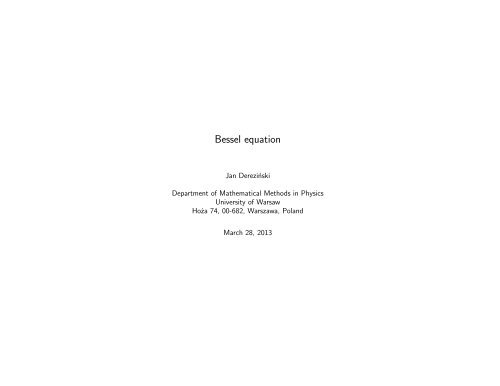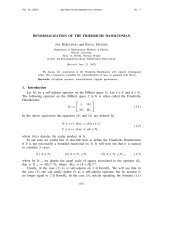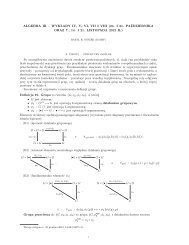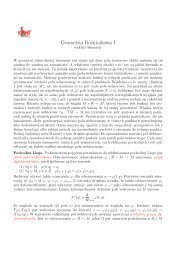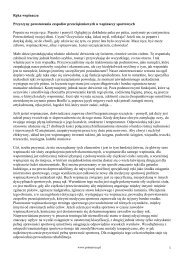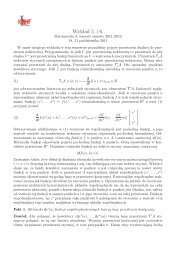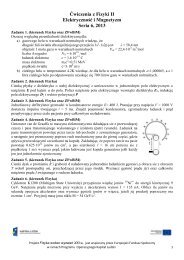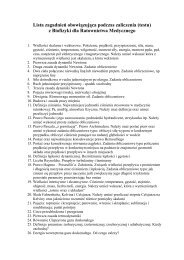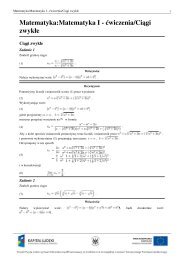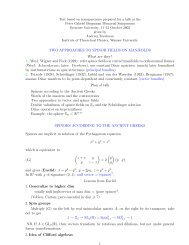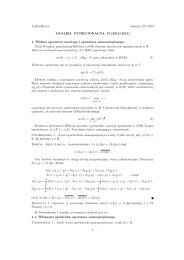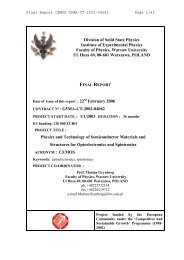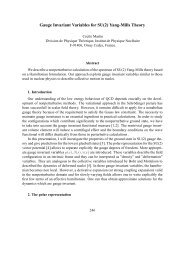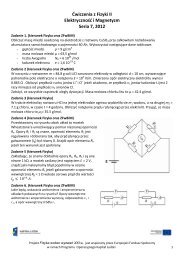Bessel equation
Bessel equation
Bessel equation
You also want an ePaper? Increase the reach of your titles
YUMPU automatically turns print PDFs into web optimized ePapers that Google loves.
<strong>Bessel</strong> <strong>equation</strong><br />
Jan Dereziński<br />
Department of Mathematical Methods in Physics<br />
University of Warsaw<br />
Ho˙za 74, 00-682, Warszawa, Poland<br />
March 28, 2013
3<br />
Chapter 1<br />
Modified <strong>Bessel</strong> <strong>equation</strong><br />
1.1 Modified <strong>Bessel</strong> <strong>equation</strong> and related <strong>equation</strong>s<br />
The modified <strong>Bessel</strong> <strong>equation</strong> has the form<br />
(z 2 ∂ 2 z + z∂z − z 2 − m 2 )v(z) = 0.<br />
One sometimes introduces the d-dimensional modified <strong>Bessel</strong> <strong>equation</strong><br />
Note the special cases<br />
d 1−<br />
z 2<br />
<br />
z 2 ∂ 2 z + z∂z − z 2 − (l + d/2 − 1) 2 d −1+<br />
z 2<br />
= (z 2 ∂ 2 z + (d − 1)z∂z + z 2 − l(l + d − 2)).<br />
z −m z 2 ∂ 2 z + z∂z − z 2 − m 2 z m<br />
= z z∂ 2 z + (1 + 2m)∂z − z , (1.1.1)
= z 2<br />
z 1 <br />
2 2 2<br />
z ∂z + z∂z − z 2 − m 2 1 −<br />
z 2<br />
<br />
∂ 2 z − 1 + 1/4 − m 2 1<br />
z 2<br />
More generally, √ tv(tδ ) = w(t) leads to the Schrödinger <strong>equation</strong> of the form<br />
<br />
∂2 t + (δtδ−1 ) 2 + ( 1<br />
4 − m2δ2 ) 1<br />
t2 <br />
+ 1 w(t) = 0. (1.1.2)<br />
Hence, if v 1<br />
ρ+1 is a solution of the modified <strong>Bessel</strong> <strong>equation</strong> with the parameter 1<br />
ρ+1 , then<br />
is a solution of<br />
1.2 Integral representations<br />
u(t) = √ tv 1<br />
ρ+1<br />
<br />
2 ρ<br />
t1+ 2<br />
ρ + 2<br />
(∂ 2 t + t ρ )u = 0.<br />
Theorem 1.2.1 <strong>Bessel</strong>–Schläfli type representations Let ]0, 1[∋ τ ↦→ γ(τ) be a contour such that<br />
<br />
z<br />
2 (t − t−1 <br />
z<br />
) + m exp<br />
2 (t + t−1 <br />
) t −m<br />
<br />
<br />
t=γ(1)<br />
= 0, (1.2.3)<br />
t=γ(0)<br />
Then <br />
γ<br />
<br />
.<br />
<br />
z<br />
exp<br />
2 (t + t−1 <br />
) t −m−1 dt (1.2.4)
Proof. We differentiate the integral with respect to the parameter z:<br />
(z 2 ∂ 2 z + z∂z − z 2 − m 2 <br />
z<br />
) exp<br />
γ 2 (t + t−1 <br />
) t −m−1 dt<br />
z 2 −1<br />
=<br />
t + t<br />
γ 2<br />
2 z −1<br />
+ t + t<br />
2<br />
− z 2 − m 2<br />
<br />
z<br />
exp<br />
2 (t + t−1 <br />
) t −m−1 dt<br />
z 2 −1<br />
=<br />
t − t<br />
γ 2<br />
2 z −1<br />
+ t + t<br />
2<br />
− m 2<br />
<br />
z<br />
exp<br />
2 (t + t−1 <br />
) t −m−1 dt<br />
<br />
z<br />
= ∂t<br />
γ 2 (t − t−1 <br />
z<br />
) + m exp<br />
2 (t + t−1 <br />
) t −m<br />
<br />
dt<br />
<br />
z<br />
=<br />
2 (t − t−1 <br />
z<br />
) + m exp<br />
2 (t + t−1 <br />
) t −m<br />
<br />
<br />
γ(1)<br />
= 0.<br />
γ(0)<br />
✷<br />
Theorem 1.2.2 Poisson type representations Let ]0, 1[∋ τ ↦→ γ(τ) be a contour such that<br />
Then<br />
(1 − t 2 1 m+<br />
)<br />
z m<br />
<br />
is a solution of the modified <strong>Bessel</strong> <strong>equation</strong>.<br />
γ<br />
<br />
<br />
2e zt<br />
γ(1)<br />
γ(0)<br />
= 0.<br />
(1 − t 2 1 m−<br />
) 2e zt dt
Proof. We use (1.1.1).<br />
<br />
2<br />
z∂z + (1 + 2m)∂z − z<br />
<br />
=<br />
γ<br />
<br />
= −<br />
1.3 Modified <strong>Bessel</strong> function<br />
γ<br />
(1 − t 2 1 m−<br />
) 2e zt dt<br />
(1 − t 2 1 m−<br />
) 2(zt 2 + (1 + 2m)t − z)e zt dt<br />
γ<br />
<br />
∂t(1 − t 2 1 m−<br />
) 2e zt<br />
<br />
dt = 0.<br />
The modified <strong>Bessel</strong> <strong>equation</strong> has a regular-singular point at 0 with the indicial <strong>equation</strong><br />
Its indices at 0 are equal to ±m.<br />
The modified <strong>Bessel</strong> function is defined as<br />
λ(λ − 1) + λ − m 2 = 0.<br />
Im(z) =<br />
∞<br />
n=0<br />
<br />
z 2n+m<br />
2<br />
n!Γ(m + n + 1) .<br />
It is a solution of the <strong>Bessel</strong> <strong>equation</strong> with the parameter ±m. Note that 1<br />
Γ(m+1) = 0 dla m =<br />
−1, −2, . . . For m = −1, −2, . . . the function Im is the unique solution of the <strong>Bessel</strong> <strong>equation</strong> satisfying<br />
Im(z) ∼<br />
<br />
z<br />
m 1<br />
, z ∼ 0,<br />
2 Γ(m + 1)<br />
which can be treated as a definition of the modified <strong>Bessel</strong> function. (By f(z) ∼ g(z), z ∼ 0, we<br />
understand that f(z) is analytic around zero and at zero equals 1.
If m ∈ Z, then I−m(z) and Im(z) are linearly independent and span the space of solutions of the<br />
modified <strong>Bessel</strong> <strong>equation</strong>.<br />
We have<br />
Im(e ±iπ z) = e ±iπm Im(z).<br />
1.4 Integral representations of modified <strong>Bessel</strong> function<br />
We start with <strong>Bessel</strong>-Schläfli-type representations. If Rez > 0, then the basic contour integral representation<br />
of Im is<br />
Im(z) = 1<br />
<br />
2πi ]−∞,0 + <br />
z<br />
exp<br />
,−∞[ 2 (t + t−1 <br />
) t −m−1 =<br />
dt (1.4.5)<br />
1<br />
<br />
z<br />
<br />
<br />
m<br />
exp s +<br />
2πi 2<br />
z2<br />
<br />
s<br />
4s<br />
−m−1 ds. (1.4.6)<br />
]−∞,0 + ,−∞[<br />
To see this note that by (1.4.5), Im is holomorphic around zero. Besides, by the Hankel identity<br />
<br />
1 1<br />
= exp (s) s<br />
Γ(m + 1) 2πi<br />
−m−1 ds.<br />
We also have<br />
]−∞,0 + ,−∞[<br />
I−m(z) = 1<br />
<br />
2πi [(0−0) + <br />
z<br />
exp<br />
] 2 (t + t−1 <br />
) t −m−1 dt. (1.4.7)<br />
Here, the contour starts at 0 from the negative side on the lower sheet, encircling 0 in the positive<br />
direction and ends at 0 from the negative side on the upper sheet,<br />
To see this we make a substitution t = s −1 in (1.4.5) noting that dt = −s −2 ds, and then we change<br />
the orientation of the contour.
Schläfli representation is just a simple consequence of (1.4.6):<br />
2π<br />
Im(z) = 1<br />
2π 0<br />
e z cos φ cos(mφ)dφ − 1<br />
π sin(mπ)<br />
0<br />
e −z cosh β−mβ dβ, Rez > 0.<br />
Next we consider various Poisson-type representations. The first is called the Poisson representation<br />
1<br />
<br />
z<br />
<br />
m 1<br />
Im(z) = √ (1 − t<br />
πΓ 2 −1<br />
2 1 m−<br />
) 2e zt dt, m > − 1<br />
2 .<br />
m + 1<br />
2<br />
∞<br />
The following Poisson-type representations are due to Hankel:<br />
1<br />
Im(z) =<br />
2πi √ π Γ<br />
<br />
1<br />
<br />
z<br />
<br />
m<br />
− m<br />
2 2 [1,−1− ,1 + 1 m−<br />
(t − 1) 2(t + 1)<br />
]<br />
1<br />
I−m(z) =<br />
2πi √ π Γ<br />
<br />
1<br />
<br />
z<br />
<br />
m 1 m−<br />
− m<br />
(t − 1) 2(t + 1)<br />
2 2<br />
[−∞,1 + ,−∞]<br />
1.5 Relationship to hypergeometric type functions<br />
m− 1<br />
2e zt dt,<br />
m− 1<br />
2e zt dt.<br />
The modified <strong>Bessel</strong> function and the hypergeometric functions 0F1 and 1F1 are closely related:<br />
m <br />
Im(z) =<br />
1.6 <strong>Bessel</strong> function for integral parameters<br />
Theorem 1.6.1<br />
=<br />
1<br />
<br />
z<br />
0F1 1 + m;<br />
Γ(m + 1) 2<br />
z2<br />
4<br />
1<br />
<br />
z<br />
m e<br />
Γ(m + 1) 2<br />
−z <br />
1F1 m + 1<br />
<br />
; 2m + 1; 2z .<br />
2
Proof. It is enough to assume that m = 0, 1, . . . .<br />
✷<br />
For m ∈ Z we have<br />
Generating function<br />
Im(z) =<br />
=<br />
=<br />
=<br />
∞<br />
n=0<br />
∞<br />
n=0<br />
∞<br />
n=m<br />
∞<br />
n=0<br />
Im(z) = 1<br />
<br />
2πi<br />
= 1<br />
2πi<br />
<br />
z 2n+m<br />
2<br />
n!(n + m)!<br />
<br />
z 2(n+m)−m<br />
2<br />
(n + m)!(n + m − m)!<br />
<br />
z 2n−m<br />
2<br />
n!(n − m)!<br />
(1.6.8)<br />
(1.6.9)<br />
(1.6.10)<br />
<br />
z 2n−m<br />
2<br />
n!Γ(n − m + 1) = I−m(z). (1.6.11)<br />
[0 + ]<br />
z<br />
2<br />
<br />
z<br />
exp<br />
2 (t + t−1 <br />
dt<br />
)<br />
tm+1 <br />
exp s + z2<br />
<br />
ds<br />
4s sm+1. m <br />
[0 + ]<br />
<br />
z<br />
exp<br />
2 (t + t−1 <br />
) =<br />
∞<br />
m=−∞<br />
t m Im(z).
Proof.<br />
✷<br />
∞<br />
m=−∞<br />
t m Im(z) =<br />
1.7 MacDonald/Basset function<br />
= <br />
<br />
n≥0, n+m≥0<br />
<br />
n≥0 n+m≥0<br />
= e z/2t e tz/2 .<br />
t m (z/2) m+2n<br />
n!(n + m)!<br />
(z/2t) n (tz/2) m+n<br />
n!(n + m)!<br />
We define the Macdonald or Basset function by a <strong>Bessel</strong>-Schláfli-type representation:<br />
Km(z) := 1<br />
∞ <br />
exp −<br />
2 0<br />
z<br />
2 (s + s−1 <br />
) s −m−1 ds<br />
= 1<br />
<br />
z<br />
exp<br />
2<br />
2 (t + t−1 <br />
) (−t) −m−1 dt.<br />
Theorem 1.7.1<br />
]−∞,0]<br />
π<br />
K−m(z) = Km(z) =<br />
2 sin πm (I−m(z) − Im(z)), (1.7.12)<br />
Im(z) = 1 <br />
Km(e<br />
iπ<br />
−iπ z) − e iπm Km(z) . (1.7.13)<br />
−1
Consider two contours on the boundary of the Riemann surface of the principal branch of t −m−1 ,<br />
each projecting onto ] − ∞, 0], I+ on the upper sheet and I− on the lower sheet, each oriented in the<br />
direction of an increasing t. We have<br />
<br />
z<br />
exp<br />
2 (t + t−1 <br />
) t −m−1 dt = −e iπm<br />
<br />
<br />
I−<br />
I+<br />
= −2e iπm Km(z),<br />
<br />
z<br />
exp<br />
2 (t + t−1 <br />
) t −m−1 dt = −e −iπm<br />
<br />
exp<br />
I−<br />
I+<br />
= −2e −iπm Km(z).<br />
<br />
z<br />
exp<br />
2 (t + t−1 <br />
) (−t) −m−1 dt<br />
<br />
z<br />
2 (t + t−1 <br />
) (−t) −m−1 dt<br />
Therefore, if I is the contour starting at 0 from the negative side on the lower sheet, encircling 0 in<br />
the positive direction and ending at 0 from the negative side on the upper sheet, we have<br />
−4i sin(πm)Km(z) = −2e iπm Km(z) + 2e −iπm Km(z)<br />
<br />
z<br />
= exp<br />
I− 2 (t + t−1 <br />
) t −m−1 <br />
z<br />
dt − exp<br />
I+ 2 (t + t−1 <br />
) t −m−1 dt<br />
<br />
<br />
z<br />
=<br />
exp<br />
2 (t + t−1 <br />
) t −m−1 <br />
z<br />
dt − exp<br />
2 (t + t−1 <br />
) t −m−1 dt<br />
]−∞,0 + ,−∞[<br />
= 2πi(Im(z) − I−m(z)).<br />
This proves (1.7.12).<br />
Next we write<br />
K(e −iπ π iπm<br />
z) = e I−m(z) − e<br />
2 sin πm<br />
−iπm Im(z) <br />
We subtract from this eiπm times (1.7.12) obtaining<br />
K(e −iπ z) − e iπm π −iπm<br />
K(z) = −e Im(z) + e<br />
2 sin πm<br />
iπm Im(z) = iπIm(z).<br />
I
This proves (1.7.13). ✷<br />
We also have a Poisson-type integral representation:<br />
Km(z) =<br />
Γ(m + 1<br />
2 )(2z)m<br />
√ π<br />
∞<br />
1.8 Asymptotics of the MacDonald/Basset function<br />
Theorem 1.8.1 For | arg z| > π − ɛ,<br />
0<br />
Km(z)<br />
lim<br />
|z|→∞ e−z√ √<br />
π<br />
2z<br />
cos(zt)(t 2 + z 2 1 −m−<br />
) 2dt.<br />
= 1.<br />
Proof. We use the steepest descent method. Set φ(t) := − 1<br />
2 (t + t−1 ). We compute<br />
φ ′ (t) = − 1<br />
2 (1 − t−2 ), φ ′′ (t) = −t −3 .<br />
Hence φ has a critical point at t0 = 1 with φ(t0) = −1 and φ ′′ (t0) = −1. Thus<br />
✷<br />
Km(z) = 1<br />
2<br />
1<br />
2<br />
∞<br />
0 ∞<br />
= 1<br />
2 e−z<br />
t −m−1 exp(zφ(t))dt<br />
<br />
exp zφ(t0) + z φ′′ (t0)<br />
(t − t0)<br />
2<br />
2<br />
<br />
dt<br />
<br />
z<br />
<br />
exp (t − 1)2 dt =<br />
2 1<br />
2 e−z<br />
√<br />
2π<br />
√z .<br />
−∞<br />
∞<br />
−∞
Corollary 1.8.2 As x → ∞ we have<br />
Im(x) ∼<br />
1.9 MacDonald/Basset function for integer parameters<br />
Theorem 1.9.1 Set h(n) := n k=1 1<br />
k . Then for m = 0, 1, 2, . . .<br />
Km(z) = (−1) m+1<br />
<br />
log z<br />
<br />
+ γ Im(z)<br />
2<br />
Proof. Set<br />
Then<br />
Besides,<br />
+ 1<br />
m−1 <br />
2<br />
k=0<br />
(−1) k<br />
<br />
z<br />
2k−m(m − k − 1)!<br />
+<br />
2 k!<br />
(−1)m<br />
2<br />
φ(z) := d 1<br />
dz Γ(z)<br />
1<br />
√ 2πx e x . (1.8.14)<br />
∞<br />
k=0<br />
= − 1<br />
Γ(z) ∂z log Γ(z).<br />
φ(−n) = (−1) n n!, n = 0, 1, 2, . . . ,<br />
φ(n + 1) =<br />
∂mIm(z) = log<br />
γ − h(n)<br />
, n = 0, 1, 2, . . .<br />
n!<br />
<br />
z<br />
<br />
Im(z) +<br />
2<br />
∞<br />
k=0<br />
φ(m + k + 1)<br />
k!<br />
h(k) + h(m + k)<br />
k!(m + k)!<br />
<br />
z<br />
m+2k .<br />
2<br />
<br />
z<br />
2k+m .<br />
2
Hence for m = 0, 1, 2, . . .<br />
<br />
<br />
∂nIn(z) =<br />
n=m<br />
<br />
<br />
∂nIn(z) =<br />
n=−m<br />
The last sum can be written as<br />
✷<br />
<br />
log z<br />
<br />
+ γ Im(z) −<br />
2<br />
∞<br />
k=0<br />
k=0<br />
h(m + k)<br />
<br />
z<br />
m+2k , (1.9.15)<br />
(m + k)!k! 2<br />
<br />
log z<br />
<br />
m−1 <br />
+ γ I−m(z) + (−1)<br />
m−k−1(m − k − 1)!<br />
<br />
z<br />
2k−m 2 k! 2<br />
−<br />
We use the De L’Hopital rule:<br />
∞<br />
k=m<br />
Km(z) = π<br />
2<br />
(1.9.16)<br />
h(−m + k)<br />
<br />
z<br />
−m+2k . (1.9.17)<br />
(−m + k)!k! 2<br />
−<br />
∞<br />
k=m<br />
= (−1)m<br />
2<br />
h(k)<br />
<br />
z<br />
m+2k .<br />
k!(k + m)! 2<br />
d<br />
dm (I−m − Im(z))<br />
d<br />
dm<br />
sin πm<br />
<br />
− d<br />
dn In(z)<br />
<br />
<br />
−<br />
n=−m d<br />
dn In(z)<br />
<br />
<br />
n=m
Corollary 1.9.2 As x → 0, we have<br />
1<br />
<br />
x<br />
m Im(x) ∼<br />
, m = −1, −2, . . . ; (1.9.18)<br />
Γ(m + 1) 2<br />
⎧<br />
Re<br />
⎪⎨<br />
Km(x) ∼<br />
⎪⎩<br />
Γ(m) <br />
2 m<br />
x if Rem = 0, m = 0;<br />
− ln <br />
x<br />
2 − γ if m = 0,<br />
Γ(m) <br />
2 m<br />
(1.9.19)<br />
2 x if Rem > 0;<br />
m if Rem < 0.<br />
1.10 Recurrence relations<br />
Theorem 1.10.1<br />
Proof.<br />
✷<br />
<br />
2∂zIm(z) =<br />
<br />
0 = 2<br />
<br />
z<br />
∂t exp<br />
γ<br />
<br />
= −2m<br />
<br />
z<br />
exp<br />
<br />
+z<br />
γ<br />
γ<br />
exp<br />
Γ(−m)<br />
2<br />
x<br />
2<br />
2∂zIm(z) = Im−1(z) + Im+1(z),<br />
2mIm(z) = zIm−1(z) − zIm+1(z).<br />
γ<br />
<br />
z<br />
exp<br />
2 (t + t−1 <br />
) (t −m + t −m−2 )dt.<br />
<br />
t −m dt<br />
2 (t + t−1 )<br />
2 (t + t−1 <br />
) t −m−1 dt<br />
<br />
z<br />
2 (t + t−1 <br />
) t −m <br />
dt − z<br />
γ<br />
<br />
z<br />
exp<br />
2 (t + t−1 <br />
) t −m−2 dt.
Corollary 1.10.2<br />
Hence<br />
1<br />
z ∂z (z m Im(z)) = z m−1 Im−1(z), or<br />
1<br />
z ∂z<br />
−m<br />
z Im(z) = z −m−1 Im+1(z), or<br />
Analoguous identities hold for Km(z).<br />
1.11 Half-integral parameters<br />
<br />
1<br />
z ∂z<br />
n z m Im(z) = z m−n Im−n(z),<br />
<br />
∂z + m<br />
<br />
Im(z) = Im−1(z),<br />
z<br />
<br />
1<br />
z ∂z<br />
n z −m Im(z) = z −m−n Im+n(z).<br />
I 1(z)<br />
=<br />
2<br />
I 1 − (z) =<br />
2<br />
K 1(z) = K 1(z) =<br />
<br />
∂z − m<br />
<br />
Im(z) = Im+1(z).<br />
z<br />
<br />
z<br />
1<br />
2 1<br />
2 Γ(1 + 1<br />
2 )<br />
sinh z<br />
z =<br />
1<br />
2 2<br />
sinh z<br />
πz<br />
<br />
z<br />
1 − 2 1<br />
2 Γ(1 − 1<br />
1<br />
2 2<br />
cosh z = cosh z,<br />
2 ) πz<br />
<br />
π<br />
1<br />
2<br />
e −z .
One way to derive these identities is<br />
1.12 Wronskian<br />
1 2n+<br />
2 2n!Γ(1/2 + n + 1) =<br />
1 2n−<br />
2 2n!Γ(−1/2 + n + 1) =<br />
π<br />
2 2n n!2 n+1 (1/2)n+1 =<br />
π<br />
2 2n n!2 n (1/2)n =<br />
The Wronskian of two solutions of the modified <strong>Bessel</strong> <strong>equation</strong> satisfies<br />
<br />
∂z + 1<br />
<br />
W (z) = 0.<br />
z<br />
Hence W (z) is proportional to 1<br />
z . Using<br />
I±m(z) ∼<br />
1<br />
Γ(±m + 1)<br />
we can compute the Wronskian of Im and I−m:<br />
W (Im, I−m) = −<br />
<br />
z<br />
±m<br />
, I<br />
2<br />
′ ±m(z) ∼<br />
<br />
π<br />
(2n + 1)!,<br />
2<br />
<br />
π<br />
2 (2n)!.<br />
1<br />
Γ(±m)<br />
2 sin πm<br />
, W (Im, Km) =<br />
πz<br />
1<br />
z .<br />
<br />
z<br />
±m−1<br />
,<br />
2
19<br />
Chapter 2<br />
Standard <strong>Bessel</strong> <strong>equation</strong><br />
2.1 <strong>Bessel</strong> <strong>equation</strong><br />
Replacing z with ±iz in the modified <strong>Bessel</strong> <strong>equation</strong> leads to the standard <strong>Bessel</strong> <strong>equation</strong>:<br />
2.2 Integral representations<br />
(z 2 ∂ 2 z + z∂z + z 2 − m 2 )v(z) = 0.<br />
Theorem 2.2.1 <strong>Bessel</strong>–Schläfli representations Let γ be a contour satisfying<br />
<br />
z<br />
2 (t + t−1 <br />
z<br />
) + m exp<br />
2 (t − t−1 <br />
1<br />
)<br />
tm <br />
γ(1)<br />
<br />
= 0, (2.2.1)<br />
Then<br />
is a solution of the <strong>Bessel</strong> <strong>equation</strong>.<br />
<br />
C<br />
γ<br />
<br />
z<br />
exp<br />
2 (t − t−1 <br />
dt<br />
)<br />
tm+1 γ(0)<br />
(2.2.2)
Theorem 2.2.2 Poisson type representations Let γ be a contour satisfying<br />
(1 − t 2 1 m+<br />
) 2e izt<br />
<br />
<br />
= 0.<br />
Then<br />
is a solution of the <strong>Bessel</strong> <strong>equation</strong>.<br />
2.3 <strong>Bessel</strong> function<br />
The <strong>Bessel</strong> function is defined as<br />
z m<br />
<br />
m iπ<br />
Jm(z) = e 2 Im(−iz)<br />
m −iπ<br />
= e 2 Im(iz)<br />
=<br />
∞<br />
n=0<br />
= 1<br />
iπ<br />
γ<br />
γ(1)<br />
γ(0)<br />
(1 − t 2 1 m−<br />
) 2e izt dt<br />
2n+m<br />
(−1) n z<br />
2<br />
n!Γ(m + n + 1)<br />
−iπ<br />
e m<br />
m<br />
2 iπ<br />
K(−iz) − e 2 K(iz) <br />
Jm(e ±iπ z) = e ±imπ Jm(z).<br />
Theorem 2.3.1 If Rez > 0, then<br />
Jm(z) = 1<br />
<br />
2πi ]−∞,0 + <br />
z<br />
exp<br />
,−∞[ 2 (t − t−1 <br />
dt<br />
)<br />
tm+1 = 1 z m <br />
<br />
exp s − z2 ds<br />
m+1 .
1<br />
Jm(z) = √ <br />
πΓ m + 1<br />
<br />
z<br />
<br />
m 1<br />
(1 − t<br />
2 −1<br />
2<br />
2 1 m−<br />
) 2e izt dt, m > − 1<br />
2 ,<br />
1<br />
Jm(z) =<br />
2πi √ π Γ<br />
<br />
1<br />
<br />
z<br />
<br />
m<br />
− m<br />
2 2 [1,−1− ,1 + 1<br />
1<br />
m−<br />
(t − 1) 2(t<br />
m−<br />
+ 1) 2,<br />
]<br />
J−m(z) = e −iπm 1<br />
2πi √ π Γ<br />
<br />
1<br />
<br />
z<br />
<br />
m 1 m−<br />
− m<br />
(t − 1) 2(t + 1)<br />
2 2<br />
[i∞,−1 + ,1 + ,i∞]<br />
2.4 Relationship to hypergeometric type functions<br />
Jm(z) =<br />
2.5 <strong>Bessel</strong> function for integral parameters<br />
Let m ∈ Z.<br />
Theorem 2.5.1<br />
=<br />
1<br />
<br />
z<br />
m <br />
0F1 1 + m; −<br />
Γ(m + 1) 2<br />
z2<br />
<br />
4<br />
1<br />
<br />
z<br />
m e<br />
Γ(m + 1) 2<br />
−iz <br />
1F1 m + 1<br />
<br />
; 2m + 1; 2iz .<br />
2<br />
Jm(z) = (−1) m J−m(z), m ∈ Z.<br />
m− 1<br />
2,
Theorem 2.5.2<br />
2.6 Hankel functions<br />
Jm(z) = 1<br />
<br />
2πi<br />
= 1<br />
=<br />
<br />
z<br />
2πi 2<br />
1<br />
π<br />
π<br />
0<br />
[0 + ]<br />
<br />
z<br />
exp<br />
2 (t − t−1 <br />
dt<br />
)<br />
tm+1 <br />
exp s − z2<br />
<br />
ds<br />
4s sm+1 m <br />
[0 + ]<br />
cos(z sin φ − mφ)dφ.<br />
There are two Hankel functions. Both are analytic continuations of the MacDonald function – one to<br />
the lower and the other to the upper part of the complex plane:<br />
Note the identities<br />
H ± m(z) = ±2 m<br />
e∓iπ 2 Km(∓iz),<br />
iπ<br />
Km(z) = ± iπ<br />
2 e±imπH ± iπ ±<br />
(e 2 z).<br />
H ± −m(z) = e ±mπi H ± m(z),<br />
Jm(z) = 1<br />
2 (H+ m(z) + H− m(z)) ,<br />
<br />
mπi + e H m(z) + e−mπiH − m(z) ,<br />
J−m(z) = 1<br />
2<br />
H ± (z) = ± ie∓mπi Jm(z)−iJ−m(z) ,
Theorem 2.6.1 The following asymptotic formulas are true for −π + δ < arg z < 2π − δ, δ > 0:<br />
lim<br />
z→∞<br />
lim<br />
z→∞<br />
2<br />
πz<br />
2<br />
πz<br />
H + m(z)<br />
1<br />
2 eize− imπ iπ<br />
2 − 4<br />
H − m(z)<br />
1<br />
imπ iπ<br />
2 e−ize 2 + 4<br />
2.7 Integral representations of Hankel functions<br />
For Rez > 0,<br />
H (1)<br />
m (z) = H + m(z) = − 1<br />
πi<br />
H (2)<br />
m (z) = H − m(z) = 1<br />
<br />
πi<br />
<br />
]−∞,(0+1·0) − [<br />
]−∞,(0+1·0) + [<br />
= 1,<br />
= 1.<br />
<br />
z<br />
exp<br />
2 (t − t−1 <br />
dt<br />
)<br />
tm+1, <br />
z<br />
exp<br />
2 (t − t−1 <br />
dt<br />
)<br />
tm+1. By ] − ∞, (0 + 1 · 0) − [ we understand the contour starting at −∞, encyrcling 0 clockwise and reaching<br />
zero from the positive direction. Similarly, by ] − ∞, (0 + 1 · 0) + [ we understand the contour starting<br />
at −∞, encyrcling 0 counterclockwise and reaching zero from the positive direction.<br />
Note that<br />
<br />
z<br />
lim<br />
t→0+1·0 2 (t + t−1 ) + m<br />
<br />
<br />
z<br />
exp<br />
2 (t − t−1 )<br />
1<br />
= 0,<br />
tm where by t → 0 + 1 · 0 we denote the convergence to zero through positive values of t (sometimes<br />
denoted by t → 0 + ). Hence the contours ] − ∞, (0 + 1 · 0) + [ i ] − ∞, (0 + 1 · 0) − [ satisfy (2.2.1).<br />
If 0 < arg z < π, then a good contour in the representation of H − m is [i∞, 0]. If −π < arg < 0,<br />
then for H + m one can use [−i∞, 0].
An appropriate choice of a contour yields the representations<br />
H − m(z) = −<br />
H + m(z) =<br />
H − m(z) = −<br />
H + m(z) =<br />
imπ<br />
ie− 2<br />
π<br />
imπ<br />
2ie 2<br />
π<br />
−imπ<br />
2ie 2<br />
π<br />
imπ<br />
ie 2<br />
π<br />
∞<br />
−∞ eiz cosh t−mtdt, 0 < arg z < π,<br />
∞<br />
0 eiz cosh t cosh(mt − imπ)dt − i π<br />
0 e−iz cos t <br />
cos mtdt , 0 < arg z < π,<br />
∞<br />
0 e−iz cosh t cosh(mt + imπ)dt + i π<br />
0 eiz cos t <br />
cos mtdt , −π < arg z < 0,<br />
∞<br />
−∞ e−iz cosh t−mtdt, −π < arg z < 0<br />
Poisson type integral representations:<br />
H − m(z) = Γ(1 2 − m)<br />
πi √ <br />
z<br />
<br />
m<br />
π 2<br />
H + m(z) = Γ(1 2 − m)<br />
πi √ <br />
z<br />
<br />
m<br />
π 2<br />
]i∞,1 + ,i∞[<br />
]i∞,−1 − ,i∞[<br />
e izt 1<br />
1<br />
m−<br />
(t − 1) 2(t<br />
m−<br />
+ 1) 2dt,<br />
e izt 1<br />
1<br />
m−<br />
(t − 1) 2(t<br />
m−<br />
+ 1) 2dt.<br />
Poisson type representations valid for m ≥ −1 2 .<br />
H − 2<br />
m(z) = −√<br />
1 πΓ(m + 2 )<br />
<br />
z<br />
<br />
m<br />
e<br />
2 ]1,i∞[<br />
izt (1 − t 2 1 m−<br />
) 2dt<br />
m π<br />
2<br />
2 − 4<br />
= zmei(z−π<br />
π )<br />
Γ(m + 1<br />
2 )<br />
∞<br />
e<br />
0<br />
−zs <br />
1 m−<br />
s 2 1 + is<br />
1 m− 2<br />
dt,<br />
2<br />
H + 2<br />
m(z) = √ 1 πΓ(m + 2 )<br />
<br />
z<br />
<br />
m<br />
e<br />
2 ]−1,i∞[<br />
izt (1 − t 2 1 m−<br />
) 2dt<br />
m π<br />
2<br />
2 − 4<br />
= zme−i(z−π<br />
π )<br />
Γ(m + 1 ∞<br />
e<br />
)<br />
−zs <br />
1 m−<br />
s 2 1 − is<br />
1 m− 2<br />
ds.<br />
2<br />
0
2.8 Neumann function<br />
Neumann function is defined as<br />
We then have<br />
Ym(z) = 2<br />
π<br />
Ym(z) = 1<br />
(1)<br />
2i H m (z) − H (2)<br />
m (z) <br />
= cos πmJm(z)−J−m(z)<br />
sin πm .<br />
H (1)<br />
m (z) = Jm(z) + iYm(z), H (2)<br />
m (z) = Jm(z) − iYm(z).<br />
Theorem 2.8.1 For m ∈ Z we have<br />
<br />
Jm(z)<br />
where h(k) := k<br />
j=1<br />
1<br />
k .<br />
− 1<br />
m−1 <br />
π<br />
k=0<br />
2.9 Recurrence relations<br />
log( z<br />
2 ) + γ<br />
(m−k−1)!<br />
k! ( z<br />
2 )2k−m − 1<br />
π<br />
Theorem 2.9.1 We have the identities<br />
∞<br />
k=0<br />
2∂zJm(z) = Jm−1(z) − Jm+1(z),<br />
2mJm(z) = zJm−1(z) + zJm+1(z).<br />
(−1) k<br />
k!(m+k)! (z<br />
2 )m+2k h(k) + h(m + k) ,<br />
Sometimes, more convenient are the following forms of the recurrence relations:
Corollary 2.9.2<br />
1<br />
z ∂z (z m Jm(z)) = z m−1 <br />
Jm−1(z), czyli ∂z + m<br />
<br />
Jm(z) = Jm−1(z),<br />
z<br />
− 1<br />
z ∂z<br />
−m<br />
z Jm(z) = z −m−1 <br />
Jm+1(z), czyli −∂z + m<br />
<br />
Jm(z) = Jm+1(z).<br />
z<br />
Besides, n 1<br />
<br />
− 1<br />
z ∂z<br />
Analogous identities hold for H ± m(z), and Ym(z).<br />
2.10 Half-integral parameters<br />
z ∂z z m Jm(z) = z m−n Jm−n(z),<br />
n z −m Jm(z) = z −m−n Jm+n(z).<br />
<br />
2<br />
J 1(z)<br />
= =<br />
2<br />
J 1 − (z) =<br />
2<br />
H ± 1 (z) =<br />
2<br />
H ±<br />
− 1<br />
2<br />
(z) =<br />
πz<br />
1<br />
2<br />
sin z,<br />
1<br />
2 2<br />
cos z,<br />
πz<br />
1<br />
2 2<br />
π ±i(z−<br />
e 2<br />
πz<br />
) ,<br />
1<br />
2 2<br />
e<br />
πz<br />
±iz
2.11 Integral of Sonine and Schafheitlin<br />
([1] Exercise 4.14, p. 236):<br />
=<br />
=<br />
∞<br />
Jm(xξ)Jk(yξ)dξ<br />
0 ξλ ykΓ <br />
1+m+k−λ<br />
2<br />
2λx1+k−λΓ(k + 1)Γ <br />
1 − m + k − λ<br />
F<br />
, 1+m−k−λ<br />
2<br />
2<br />
1 + m + k − λ<br />
; k + 1;<br />
2<br />
y2<br />
x2 <br />
, y < x;<br />
xmΓ <br />
1+m+k−λ<br />
2<br />
2λy1+m−λΓ(m + 1)Γ <br />
1 + m − k − λ<br />
F<br />
, 1−m+k−λ<br />
2<br />
2<br />
1 + m + k − λ<br />
; m + 1;<br />
2<br />
x2<br />
y2 <br />
, x < y.<br />
2.12 Wronskians of solutions of the <strong>Bessel</strong> <strong>equation</strong><br />
The Wronskian of two solutions of the <strong>Bessel</strong> <strong>equation</strong> satisfies<br />
Hence W (z) is proportional to 1<br />
z . Using<br />
J±m(z) ∼<br />
<br />
∂z + 1<br />
W (z) = 0.<br />
z<br />
we can compute the Wronskian of Jm(z) and J−m(z):<br />
W (Jm, J−m) = −<br />
1<br />
Γ(±m+1) (z<br />
2 )±m , J ′ ±m(z) ∼ 1<br />
Γ(±m) (z<br />
2 )±m−1 ,<br />
2 sin πm<br />
, W (H<br />
πz<br />
− m, H + m) = − 4i<br />
πz , W (Jm, Ym) = 2<br />
πz .
29<br />
Chapter 3<br />
Separation of variables in the Laplacian<br />
and the <strong>Bessel</strong> <strong>equation</strong><br />
3.1 Euclidean Lie algebra in dimension two<br />
In R2 we introduce the polar coordinates<br />
x = r cos φ = r<br />
2 (w + w−1 ),<br />
y = r sin φ = r<br />
2i (w − w−1 ),<br />
where w = eiφ . The polar coordinates can be interpreted as a unitary map<br />
or<br />
U1 : L 2 (R 2 ) → L 2 ([0, ∞[, r 1/2 ) ⊗ L 2 ([−π, π]),<br />
U1f(r, φ) = f(r cos φ, r sin φ).<br />
U2 : L 2 (R 2 ) → L 2 ([0, ∞[, r 1/2 ) ⊗ L 2 ([−1, 1], (1 − w 2 ) 1/2 ),<br />
U2f(r, w) = f(rw, r(1 − w 2 ) 1/2 ).
Note that<br />
We will use<br />
Note the relations<br />
The <strong>equation</strong><br />
∂x = cos φ∂r − r sin φ∂φ,<br />
∂y = cos φ∂r + r cos φ∂φ.<br />
L := x∂y − y∂x = ∂φ = iw∂w,<br />
A + := ∂x + i∂y = w(∂r + ir −1 ∂φ) = w(∂r − r −1 w∂w),<br />
A − := ∂x − i∂y = w −1 (∂r − ir −1 ∂φ) = w −1 (∂r + r −1 w∂w),<br />
∆ := ∂ 2 x + ∂ 2 y = ∂ 2 r + r −1 ∂r + r −2 ∂ 2 φ = ∂2 r + r −1 ∂r − r −2 (w∂w) 2 .<br />
[A + , A − ] = 0,<br />
[A ± , L] = ±A ± ,<br />
∆ = A + A − = A − A + ,<br />
[∆, L] = [∆, A ± ] = 0.<br />
−∆ = −1,<br />
−∆ = = 1<br />
restricted to the subspace L = m coincides respectively with the modified/unmodified <strong>Bessel</strong> <strong>equation</strong>.<br />
3.2 Helmholtz <strong>equation</strong> in dimension 2<br />
The Helmholtz <strong>equation</strong>
has a solution in the form of a plane wave propagating at the angle ψ, in the Catesian coordinates<br />
equal<br />
and in polar coordinates equal<br />
i(x cos ψ+y sin ψ)<br />
fψ(x, y) := e<br />
fψ(r, φ) = e ir cos(φ−ψ) .<br />
L commutes with ∆, therefore we can look for a solution of<br />
(∆ + 1)f = 0, Lf = imf.<br />
It is solved by a circular wave equal in the polar coordinates<br />
fm(r, φ) = Jm(r)e imφ .<br />
Theorem 3.2.1 A plane wave can be decomposed into circular waves:<br />
∞<br />
fψ(r, φ) =<br />
m=−∞<br />
A circular wave can bedecomposed into plane waves:<br />
i m fm(r, φ) = 1<br />
2π<br />
i m fm(r, φ)e −imψ . (3.2.1)<br />
2π<br />
Proof. To obtain (3.2.1) we take the formula for the generating function<br />
∞<br />
t m Jm(r)<br />
π i(φ−ψ+ and insert t = e 2 ) .<br />
e r<br />
2 (t−t−1 ) =<br />
0<br />
m=−∞<br />
fψ(r, φ)e imψ dψ. (3.2.2)
To obtain (3.2.2) we take<br />
π −i(ψ− substitute t = e 2 ) and multiply by ieimφ . ✷<br />
3.3 Graf addition formula<br />
Jm(r) = 1<br />
<br />
2πi [0] +<br />
e ir(t−t−1 ) −m−1<br />
t dt,<br />
The following formula can be interpreted as follows: a circular wave in one polar coordinate can be<br />
decomposed into circular waves in another polar coordinate system:<br />
Theorem 3.3.1 Assume that R, r, ρ and Φ, φ, ψ are related as<br />
Then<br />
R =<br />
<br />
(reiφ + ρeiψ )(re−iφ + ρe−iψ ), e iΦ <br />
=<br />
Jm(R)e imΦ =<br />
∞<br />
n=−∞<br />
Jm−n(r)e i(m−n)φ Jn(ρ)e inψ .<br />
reiφ + ρeiψ re−iφ .<br />
+ ρe−iψ If m ∈ Z, then there are no restrictions on the parameters in the formula. If m is nonintegral and all<br />
variables real, then one has to assume that ρ < r (or, equivalently, |Φ − φ| < π).<br />
We can then replace<br />
(i)<br />
2
Proof. We put ˜ ψ = ψ − φ, ˜ Φ = Φ − φ. Then the problem is reduced to the case φ = 0.<br />
∞ n=−∞<br />
= 1 ∞ 2πi n=−∞<br />
= 1<br />
2πi<br />
= 1<br />
2πi<br />
inψ<br />
Jm−n(r)Jn(ρ)e<br />
<br />
γ exp r<br />
2 (t − t−1 ) t−m−1Jn(ρ)(teiψ ) n<br />
<br />
γ exp<br />
<br />
r<br />
2 (t − t−1 ) + ρ<br />
iψ iψ −1<br />
2 te − (te ) <br />
t−m−1dt <br />
γ exp R<br />
2 (s − s−1 ) s−m−1dseimΦ = eimΦJm(R), where in the last step we used r + ρe iψ = Re iΦ and turned the contour. ✷<br />
Substituting<br />
we obtain<br />
and the addition formula can be rewritten as<br />
Jm( x 2 + y 2 )<br />
x+iy<br />
√ x 2 +y 2<br />
m<br />
x1 = r cos φ, y = r sin φ,<br />
x2 = ρ cos ψ, y2 = ρ sin ψ,<br />
x = R cos Φ, y = R sin Φ,<br />
(x1, y1) + (x2, y2) = (x + y)<br />
= <br />
n∈Z Jm−n( x 2 1 + y2 1 )<br />
Define an operator on L 2 (Z) given by the matrix<br />
Um,n(x, y) := Jm−n( x 2 + y 2 )<br />
x1+iy1<br />
√ x 2 1 +y 2 1<br />
x+iy<br />
√ x 2 +y 2<br />
Then U(x, y) −1 = U(−x, −y), U(x, y) is a unitary matrix, that is<br />
Un,m(x, y) = Um,n(−x, −y),<br />
m−n Jn( x2 2 + y2 2 )<br />
<br />
x2+iy2 √<br />
x2 2 +y2 n .<br />
2<br />
m−n
and R2 ∋ (x, y) ↦→ U(x, y) is a group representation, that means<br />
∞<br />
Uk,n(x2 + x1, y2 + y1) =<br />
m=−∞<br />
Uk,m(x2, y2)Um,n(x1, y1).<br />
Extend this representation to the affine orthogonal group on R 2 . This group can be parametrized<br />
by R 2 × S 1 . The action is defined as<br />
(x2, y2, θ2)(x1, y1, θ1) = (x2 cos θ1 + y2 sin θ1 + x1, −x2 sin θ1 + y2 sin θ1 + y1, θ2 + θ1).<br />
The representation is defined as follows:<br />
R 2 × S 1 ∋ (x, y, θ) ↦→ U(x, y, θ),<br />
Um,n,θ(x, y) := e imθ Jm−n( x 2 + y 2 )<br />
x+iy<br />
√ x 2 +y 2<br />
m−n<br />
.<br />
Then U(x, y, θ) is a unitary matrix and it is a representation, that means<br />
<br />
<br />
(x2, y2, θ2)(x1, y1, θ1) =<br />
∞<br />
Uk,m(x2, y2, θ2)Um,n(x1, y1, θ1).<br />
3.4 ...<br />
Identity<br />
Uk,n<br />
(2m + κ) (1 − w2 )<br />
∂w + (2m + κ)w∂r =<br />
r<br />
m=−∞<br />
<br />
m + κ<br />
mw 2<br />
+ ∂r + (1 − w )∂w<br />
r<br />
m<br />
2<br />
+ − ∂r − (m + κ)w + (1 − w )∂w .<br />
r
35<br />
Bibliography<br />
[1] Andrews, G.E., Askey, R., Roy, R.: Special functions, Cambridge University Press, 1999<br />
[2] Everitt, W.N. and Kalf, H.: The <strong>Bessel</strong> differential <strong>equation</strong> and the Hankel transform, to appear<br />
in J. Comput. Appl. Math.<br />
[3] Watson, G.N. A treatise on the theory of <strong>Bessel</strong> functions, Cambridge University Press, 2nd ed.<br />
1948<br />
[4] Titchmarsh, E.C.: Eigenfunction expansions I, Oxford University Press, 2nd ed. 1962


